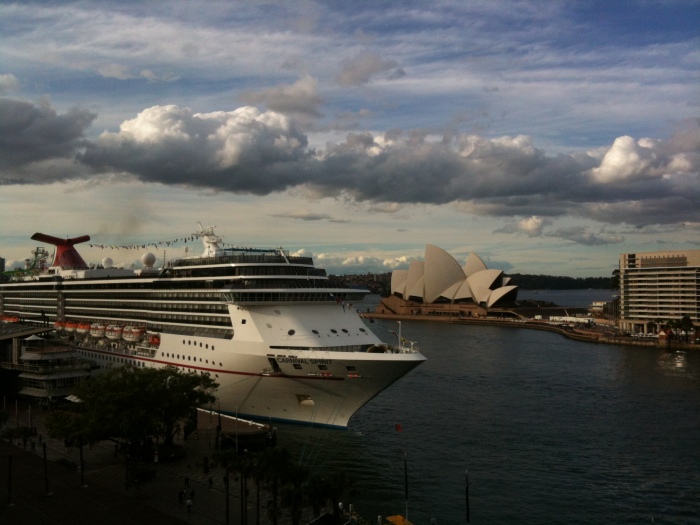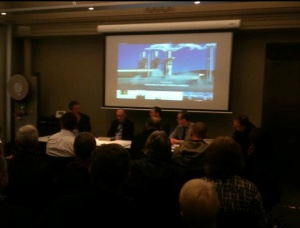Posts Tagged ‘e-publishing’
A newbie’s quick road-test of The Age newspaper’s iPad app
By Kaye Blum
Attending yesterday’s Cool New Toys session at MWF2011 has provoked further reflection on some of the comments that were made by the audience, including myself, regarding Fairfax Media’s newspaper apps for tablets.
I only recently bought an iPad2 and have barely had the chance to give it a thorough road-test. I did, however, download the free app for The Age from iTunes. I didn’t really know what to expect but I was very pleasantly surprised. With sponsorship from Telstra, they’re offering a free trial (for a limited time) of the daily plus weekend editions and most of the supplements. There’s no indication of how long the free trial lasts or when users will be asked to subscribe, so I’m making the most of it and am thoroughly enjoying the experience as an iPad newbie.
I’ve never been a daily newspaper reader – too time-poor, broadsheets too big and difficult to read on a packed peak-hour train – but I do love browsing the weekend editions. When I’m living in Melbourne, I also buy The Age on Thursday for the Green Guide, an excellent supplement with a critical guide to the week’s television programs; and the EG (Entertainment Guide) in Friday’s paper which provides a comprehensive listing of all the live music gigs and other interesting happenings in Melbourne for the week.
I was impressed to find both supplements provided in the iPad app. However, the Green Guide doesn’t provide the full TV guide that comes in the printed version, which is disappointing. Yet the EG provides a full gig guide listing as per the print version. As a live music fan, this really got me in.
I’ve used The Age app the most often out of the 20-odd apps I downloaded in my first week with an iPad. The interface is reasonably intuitive; I love the scroll and swipe format and that I don’t need my glasses to read the text. I appreciate the occasional video content added to a story which is relevant and enhancing rather than superfluous and unnecessary. I also like that I don’t have to go to the shop to buy the paper and that I don’t have to deal with a broadsheet blowing in the wind or taking up too much space on the coffee table. And no more inky fingers. The advertising is minimal and unobtrusive (so far). Then there’s the whole environmental can of worms of not using paper; although I’ve raised the issue of energy consumption for the production of e-books at previous conferences and there doesn’t seem to be a cut-and-dry comparison of the environmental impacts of e-publishing that I’m aware of – I guess it’s still early days.
So, at yesterday’s Cool New Toys session, I expressed my enthusiasm for The Age app and asked Stephen Hutcheon, tablet editor of the Sydney Morning Herald (sister publication of The Age), how they managed the formatting process from print to app on a daily basis. He said they’d retrained some of their print designers and they work from 6pm until 2am re-formatting the print content into the interactive version for the app.
Another audience member completely disagreed with my enthusiasm, stating that the app didn’t seem to have all the content of the paper version and was not updated as quickly as the website. So in his view, as a news source, it was disappointing and he was not interested in subscribing. In my view, the app isn’t meant to be the kind of instant news source that the web delivers. Tablets are a ‘lean-back’ device (as opposed to leaning forward to view and interact with a computer). This term was used by a panelist yesterday, but I first heard interactive media specialist Jennifer Wilson use it several years ago at a new media conference in Byron Bay.
I’m using my tablet on the couch and in bed. I don’t use it for writing – the keys are too sensitive; the return key is where the colon key should be which I keep hitting by mistake. I can’t type fast enough on it. I was hoping it would replace my notebook in lectures but I’m not sure I can master touch-typing on it, so for now I use it mainly for reading. And I love it for just that. Any serious research or work can be done much quicker on my laptop, with two hands. For now, my iPad is a ‘one-hand’ device: tap, touch, swipe. My other hand is free to sip my cup of tea. As William Powers said yesterday, it’s difficult to multi-task on the tablet and that actually allows us to focus more on the material we’re reading. I see that as a real plus for my easily distracted attention-span.
Today I’ve revisited The Age iPad app with a more critical eye. I’ve chosen an article from the Daily Edition, Editor’s Choice. Two taps and I’m there. The article is from the Good Weekend supplement and is titled The Old Spice man cometh. Written by Bernard Lagan, it’s a feature article and interview with the video director of last year’s viral marketing sensation for Old Spice, Tom Kuntz. At the top of the article is video footage – a snappy show-reel of Kuntz’s most prolific commercials, including the Old Spice man ad; another award-winner, the Cadbury Eyebrows ad; and a few I haven’t seen before. Excellent – I get to watch these entertaining clips in crisp digital quality without having to leave the app.
There are four photographs accompanying the article. Three are stills from some of the video clips, the other is a shot of Kuntz on set filming his latest ad. They’re reasonably small (about 3x4cm) and I want to see a larger version of the Kuntz image, which is quite an interesting but busy location shot. I tap the screen hoping it will enlarge. It doesn’t. Disappointing. Tablets provide a stunning platform for good photography so it’s a shame it isn’t enhanced in this format. But I guess there’s only so much a small team of designers can do to turn a daily paper into an app overnight.
In the article, Kuntz’s website is mentioned but there’s no hyperlink. I’m assuming this is an editorial decision to prevent readers from leaving the app. If I want to check out his website I’ll have to jot down the URL (or copy and paste it into a memo) and check it out later. It’s probably a good thing – I’m not distracted from the article, I keep my focus.
At the end of the article there’s no ability for readers to leave a comment. This was a point raised at the panel session yesterday by an audience member. But it seems this is another feature that newspapers are choosing to leave to the web. The iPad app enables me to share the article via email, on Twitter or Facebook and I can even add it to a list of my saved articles which is easily accessible back on the main menu. Is this enough? It is for me.
Do I think it’s worth a subscription fee? Absolutely. The reading experience is enhanced and I will actually consume more content in this format than if I had to go out and buy the printed edition. So now I’m going back to bed to enjoy reading the weekend papers on my iPad, without the inky fingers.
Have you road-tested any newspaper apps on a tablet device? Let me know what you think.
(c) 2011 Kaye Blum.
Cool new toys at MWF2011
By Kaye Blum
I’ve just attended my first session at this year’s Melbourne Writers Festival. Weeks ago, I scoured the program and selected sessions with a technology theme. This session was free and booked out quickly, so I’m glad I got in early. The focus was on iPads and other tablets and their impact on journalism.
The panel comprised David Higgins (News Limited’s innovations editor), Craig Butt (digital producer at Melbourne Press Club), William Powers (media and technology journalist and author of Hamlet’s Blackberry) and Stephen Hutcheon (tablet editor of the Sydney Morning Herald). It was chaired by Swinburne senior lecturer Andrew Dodd.
Craig Butt opened with an overview of some of the most innovative tools for tech-savvy journalists: Tweetdeck; Audioboo, which can record up to five minutes of audio for instant uploading; and Qik, which enables you to upload, tag and share video recordings taken from smartphones.
David Higgins talked about aggregators: Feedly; Storify (which I’ve already used and love); and GoogleFusion, which is used by The Guardian. “Professional journalism is now in the hands of everyday people,” he said. Indeed it is.
Stephen Hutcheon talked about the non-linear nature of tablets, claiming it is a “lean-back device” that solves the problem of the small screen on mobile phones. “Most people are looking at it in bed,” he added. He believes the future is in bespoke app’s such as the one created for Le Tour de France and ABC’s food app. “This is where the real growth prospects are.”
William Powers noted that it’s hard to multi-task on tablets, which he believes is a good thing, because it helps maintain focus (unlike the multiple distractions online). “We need to be more strategic about how we use these tools,” he added.
My favourite quote from this session, from Powers again: “We are at the very beginning of this [digital] revolution… it’s exciting… but we’ve got a long way to go.”
(c) 2011 Kaye Blum.


